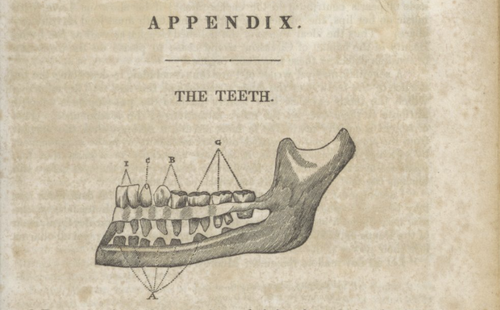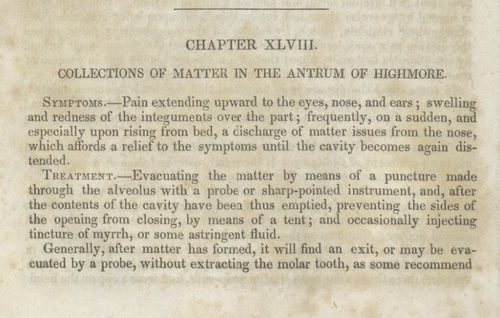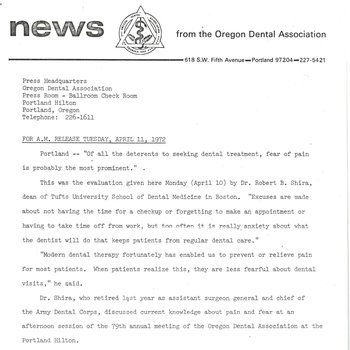<h3 style="margin-left: 1.5em">Poultices, Placebos, & Progress</h3>
<p style="margin-left: 2.5em">Before the development of the field of dentistry and modern science, humans had to attempt to alleviate dental pain through methods of their own devising. Many of these methods were relatively harmless given the limitations of their time, however some were actively harmful, while others have led to the invention of beneficial modern treatments, such as with white willow and aspirin.</p>
<p style="margin-left: 2.5em"> Items in this collection offer a sampling of the different ways we have attempted to alleviate orofacial pain over time, including folk beliefs and early medical thought. Also included in this collection are items attempting to dispel discredited pain management theories from earlier eras and campaigns against related pain relief misinformation. For more information on combatting misinformation, see our exhibit on fluoride [<i>coming soon</i>]!</p>
<p style="margin-left: 2.5em"> Click the images below to learn more about items in the ADA Commons collection. Scroll down to see related materials from outside the ADA Commons holdings.</p>
<p style="font-size: .8em; margin-bottom: -1rem; text-align: right"><i>Banner image courtesy of the National Library of Medicine</i></p>
<br>
<h4 style="margin-left: 1em; margin-bottom: -1rem">Images courtesy of the National Library of Medicine</h4>
<p><i>Please note that images in this section have been pulled from the text and annotated here for emphasis or clarity.</i></p>

<br>
<br>
<p><b><i><a href="https://collections.nlm.nih.gov/catalog/nlm:nlmuid-101743940-bk"><b>The family physician ; or, The reformed practice of medicine: on vegetable or botanical principles : being a compendium of the "American practice"</a></i> is an 1845 guide to the use of botanical materials, among other methods, for the treatment of illness.</b></p>
<p>The author, Wooster Beach, did not use the traditional practices of the day such as blood-letting and purging and gave an uncommon amount of focus to tooth care for his time, dedicating an entire appendix of this text to the care of teeth (left).</p>
<br>
<br>

<br>
<br>
<p>Beach formed the school of “eclectic medicine” which faded in the mid-20th century but the roots of which can be seen in today’s holistic treatments. He promoted a “reformed” medical methodology using plants and herbs, including white willow bark (salix alba - where salicylic acid gets its name), which has historically been used to treat rheumatism, known commonly as aches and pains or sometimes referring to arthritis.</p>
<br>
<br>
<br>
<br>
<br>

<br>
<p>Treatments for a variety of dental ailments are featured throughout the <i>The family physician</i>, including general pain (above left) and specific directives for dentistry during pregnancy (below left).</p>
<br>
<br>

<br>
<br>
Beach also discusses orofacial pain throughout the text, however at this time the discipline was not untangled from others within medicine, as exemplified in this excerpt on relief from maxillary sinus pressure (left).</p>
<p>Note that at the bottom of the paragraph he mentions that his listed method can provide relief for the patient "without extracting the molar" - perhaps an early example of medicine separating into disciplines.</p>
<br>
<br>
<br>

<br>
<br>
<p>Although not all of his methods were safe by modern standards, Beach strongly advocated against common and egregiously harmful medical practices of his time, such as mercury (left), and some of his more beneficial prescribed treatments are even related to our modern medications.</p>



